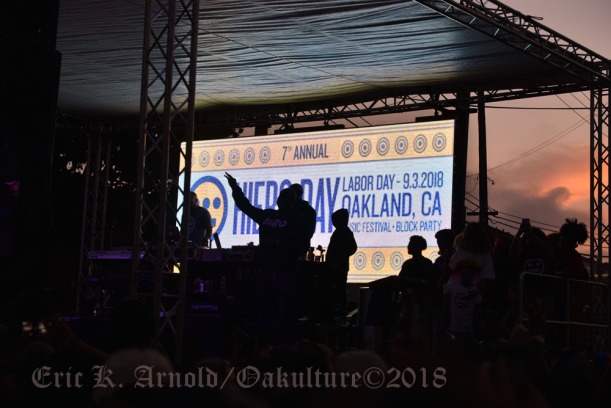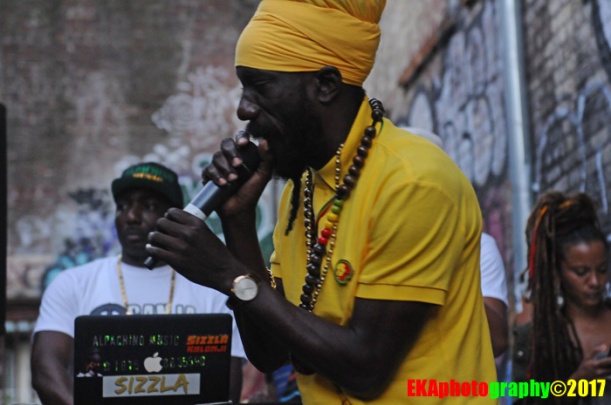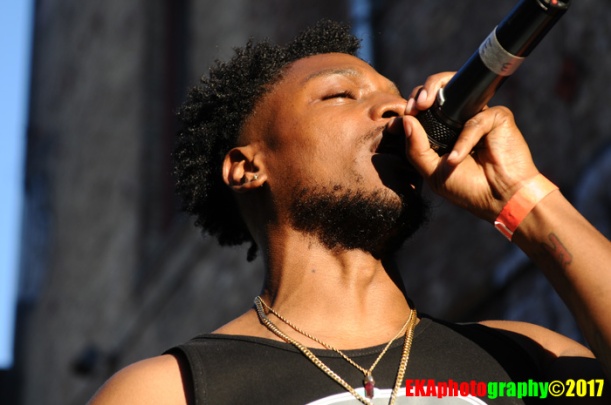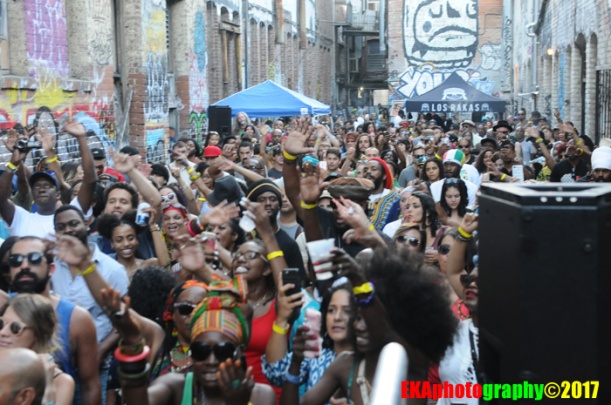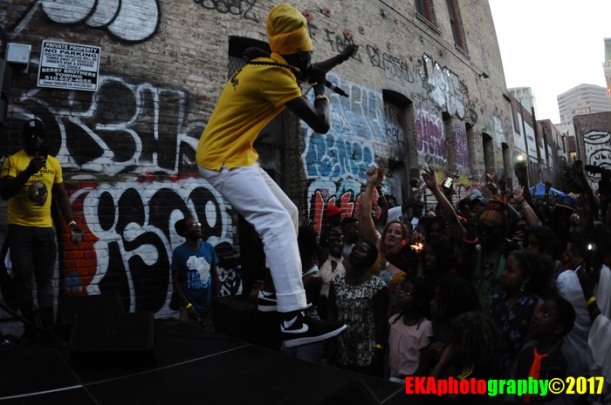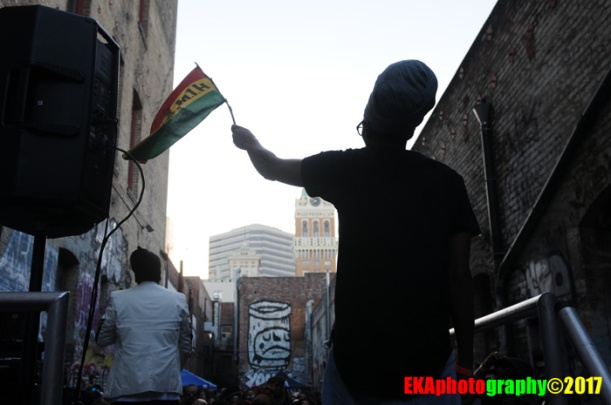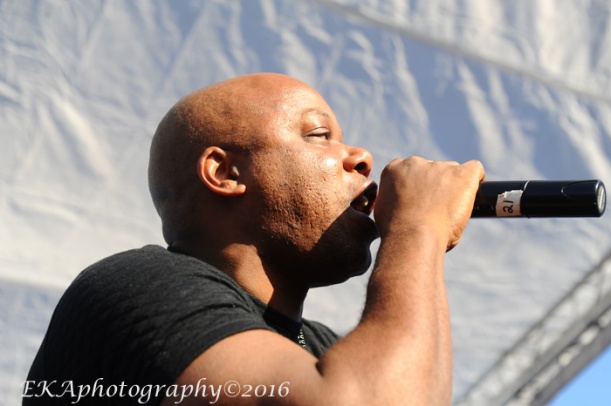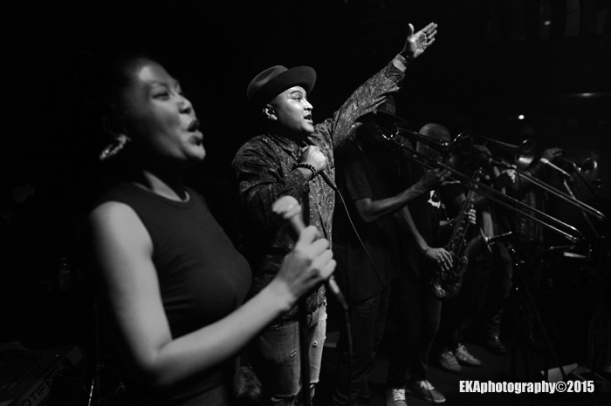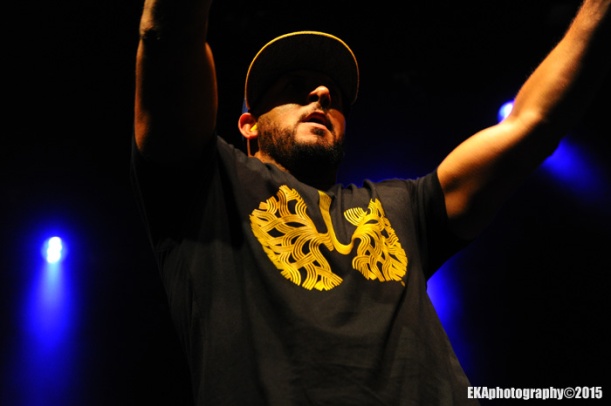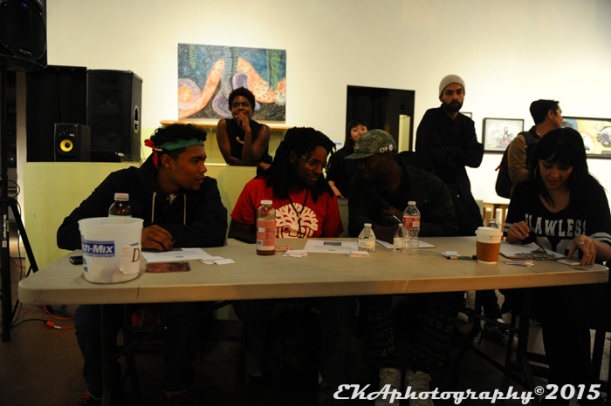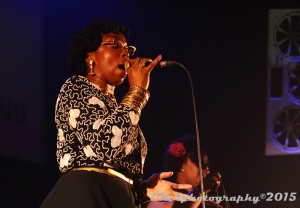
This year’s installment of Hiero Day — which has become one of the most significant hip-hop parties in the nation, if not the globe — may have been the most satisfying iteration to date. By the time evening rolled around and the locally-bred Hieroglyphics crew hit the instantly-recognizable opening notes of “93 Til Infinity,” the experience had become epic.
It’s always interesting to arrive at a music festival early, when things are just starting. There was a good reason for early arrival, however: an all-to-brief set by Umar Bin Hassan, best known as one of the driving forces behind the Last Poets, the pioneering group who infused spoken word with street-level imagery, cultural nationalism, and a sociopolitical worldview. The Last Poets have been called the Godfathers of rap, and the tradition of “woke”-ness in hip-hop has a starting point in songs like “When the Revolution Comes” and “Mean Machine.” They’ve been sampled by Notorious B.I.G., and covered by Public Enemy, yet their contributions to the artform and the culture aren’t as widely-known as they should be.
Bin Hassan’s set was short but significant, in that it connected rap’s origins with its present-day manifestation. He closed with “This Is Madness”, the title track of the classic 1971 album. Strangely enough, the song’s dystopian lyrics seemed just as relevant in the Trumpian era as they were during the Nixon presidency.
As host Mistah F.A.B. noted, at the time the Last Poets emerged, “trhey was still hanging us. Let me say that. We was still getting killed for reckless eyeballing. We were still getting locked up like we are today, at higher rates than we was in the South. So for a brother to come out with poems like that, the whole Last Poets, allof the brothers, man, to be here today, I’m honored just to share the stage with him.”

After his set, Bin Hassan hung out for a while in VIP by the main stage, taking it all in. There was a lot to take in, indeed, Besides the main stage, there were two other stages with full lineups, vendors galore, a food truck area, a kids’ area – a sure sign hip-hop is grown—and live painting by graffiti legend Crayone.
As the day progressed, thousands of attendees began to fill up the staging area, which had a different configuration than the 2016 festival, also held in the general 3rd St. location. The main stage faced westerly, which meant that attendees were looking directly into the sun for most of the afternoon.
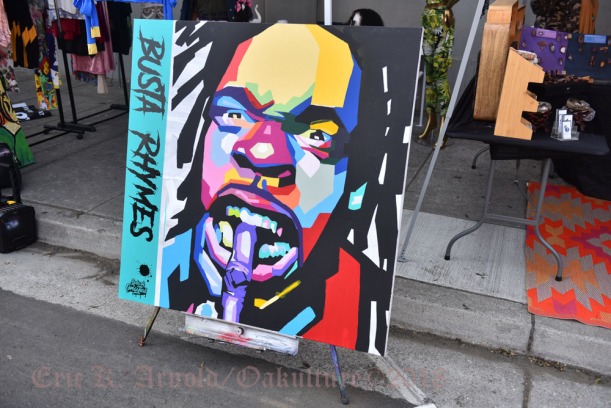
As a veteran of many Hiero Days, one thing Oakulture has learned is, you can’t be everywhere at once. So while forays were made through the vending and food areas, and the two secondary stages, the place to be was around the main stage, where most of the action was – although word has it that Ryan Austin and Chinaka Hodge killed it, as did Chali 2na’s performance and Mannie Fresh’s DJ set.

For the occasion, F.A.B. donned a bright red hoodie-and-sweatpants combo advertising his clothing company Dope Era. Never one to under-accessorize, F.A.B. also sported a Dope Era backpack and gold chain. The charismatic host shuttled between exhorting the crowd to get loud, relaying anecdotes, and performing some of his own songs, like the hyphy era anthem, “Super Sic Wid It”

A major highlight was Richie Rich’s set. Before he came on, F.A.B. again contextualized the moment, proclaiming Rich “raised” him. “This dude was one of the first dudes to really show me what it was like to be a real Oakland stunna, to represent the town all around the world… when I heard this dude was on the performance list, I was hella juiced.”
In the Bay Area pantheon, “Dubble R” occupies a rather unique roost. A founding member of 415 who later signed to Def Jam before going indie, he’s among the few OG pioneers of Bay Area rap who’s still actively recording.
Richie Rich’s Hiero Day set was heated. The soil-savvy yet lyrical mic presence he displayed was something up-and-coming artists could learn a thing or two from. The crowd’s energy level jumped significantly when he too the stage. Audible cheers of excitement ensued when he performed the classics “Ain’t Gon Do” and “Let’s Ride.” He appeared to leave the crowd wanting more, until he reappeared, flanked by F.A.B., for a rendition of the all-time Oakland anthem, “Sideshow.”

Another bright note was Mike Relm’s video turntablism display. Relm—who started out as a member of Supernatural Turntable Artists, then shot to fame with the Blue Man Group—has mastered the art of mixing music videos, mashing up visuals as well as audio. This injects an added sense of excitement into DJ routines because of the enhanced visual component. Relm might appear to be The Nerdiest Guy on the Planet—an image he has carefully cultivated—but he is an absolute beast on the tables, so don’t ever sleep on him.
Relm was followed by a very laid-back Talib Kweli, who recounted a story of coming to Oakland in 1996 and hanging out with members of Hiero. It was a subtle reminder that Hiero Day is built on relationships in the artist community which extend back decades, as opposed to a corporate festival where money is the only commonality. The phrase “for the culture” gets bandied about a lot, and sometimes in cliched ways, but there is absolutely nothing cliched about a grassroots event which built itself up from its own bootstraps – which could be said about the Hiero organization as well (more on that in a minute).
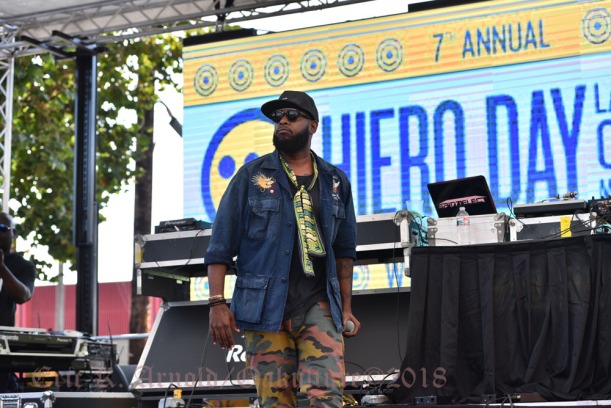
Kweli’s set cruised through hits like “The Blast,””Get By,” and “Redefinition,” before the Brooklyn emcee gave way to Southern Cali’s Pharcyde. Now down to just two original members—Imani and Bootie Brown, the group still was able to muster considerable stage command, especially on their closing tune, “Passing Me By,” which turned into a sing-along with several thousand people – indeed, the staging area had become a dense thicket of bodies.

By now, the sun’s merciless rays had begun to ease a bit, setting the stage for an otherworldly set by Black Thought. The Roots’ headmaster made his first Hiero Day appearance one for the history books. If you think you have heard dope emcees before, you really haven’t heard anything until you’ve heard Thought do a solo set, backed by just a trumpeter and a give tapping out beats on an MPC. Tarik Trotter simply put on a rhyme clinic, scoring high marks for subject matter, flow, breath control, vocabulary, tonality, and several other metrics which may come to mind later. He held the mic like a staff, emanating a vibe of hip-hop royalty. Fronting on Thought was simply not an option; he basically exuded greatness from every pore, as he poured on the similes and metaphors.

The coup de gras was the special guest he brought out, none other than Sa-Roc. Though she looked graceful, even demure, she beasted the mic with an impressive display of skills and finesse which served as dessert to Thought’s entrée. Definitely keep an eye out for her.

At this point in the day, the show was running a bit over, which cut into the headliner’s time. Which is also a testament to Hiero’s aesthetic . Most groups in that position, especially at their own festival, would have cut the time of one of the other acts; to cut your own set speaks to their integrity.

Their 30-minute slot was cut down to maybe about 20 minutes. But lest anyone complain, they more then made up for it in intensity, bum-rushing the stage like they were hungry for their first taste of success.
If you’ve followed Hiero for a while, you know they function as a collective unit with distinct personalities: Casual mixes physical and verbal aggression with subtly complex rhyme patterns and battle-rapper bravado; Tajai—who sported a black and gold African-patterned robe straight outta Wakanda—evoked the image of a high priest or wizard of some mystical Afrocentric sect; the underrated Pep Love is a fount of lyrical dopeness and hip-hop aesthetics; Phesto Dee mixes sporty flair with a subtle sense of humor (he had on some shades with the Hiero symbol on the lenses); and A+ and Opio are deceptively laid-back cats who deliver devastating ninja strikes causing verbal lacerations. Producer Domino and DJ Toure stoically play the background, but also serve as grounded focal points – the crew likes to move around a lot onstage. Missing in action was Hiero founded Del—a zany character if there ever was one—who is still recovering from a recent illness.

Hiero’s energetic set went by quickly, but every moment was befitting of a prime-time performance. After seeing them live countless times, the way they complement each other never ceases to amaze. They never get in each other’s way, seeming to employ telepathic commands, or maybe just intuition born from working alongside each other for three decades. It would have been dope to hear a full set of classics, but the songs we did hear, including two newer songs and the now 20 year-old “You Never Knew” were lapp[ed up like milk by the crowd, leading up to “93 til,” a song whose most enduring quality may be that it never gets old.
Some final thoughts: Hiero Day covers a fair amount of the hip-hop spectrum, and presents the genre as united—as opposed to subdivided by style or region. In doing so, it transcends subjective biases. The mix of up-and-coming and veteran artists not only challenges fans to be open-minded and encourages embracing of groups they may be unfamiliar with, but also means each and every Hiero Day is similar yet different.

Unlike most rap shows—which tend to either target younger or older audiences—Hiero Day has broad, multigenerational appeal. This also helps explain Hieroglyphics’ longevity: they keep attracting younger fans while retaining longtime listeners, essentially turning over their fan base. It’s a brilliant marketing model.
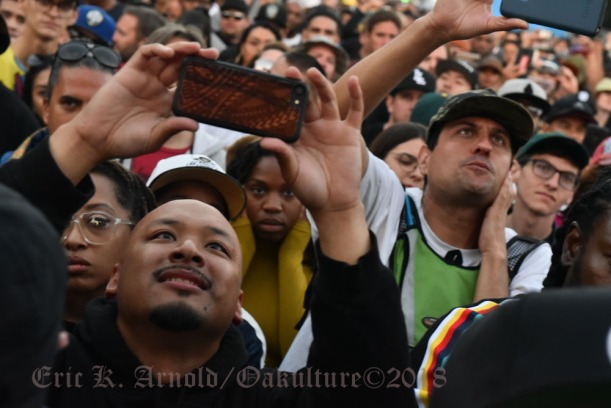
While similar festivals like Summer Jam or Rock the Bells have attracted large numbers of hip-hop aficionados over the years, neither event has ever felt truly organic. There’s a DIY mentality afoot at Hiero Day which makes mainstream or overly-commercial rap seem completely irrelevant. From an audience perspective, there may be some performers you especially want to see, but a greater sense that folks are there for the overall experience.
